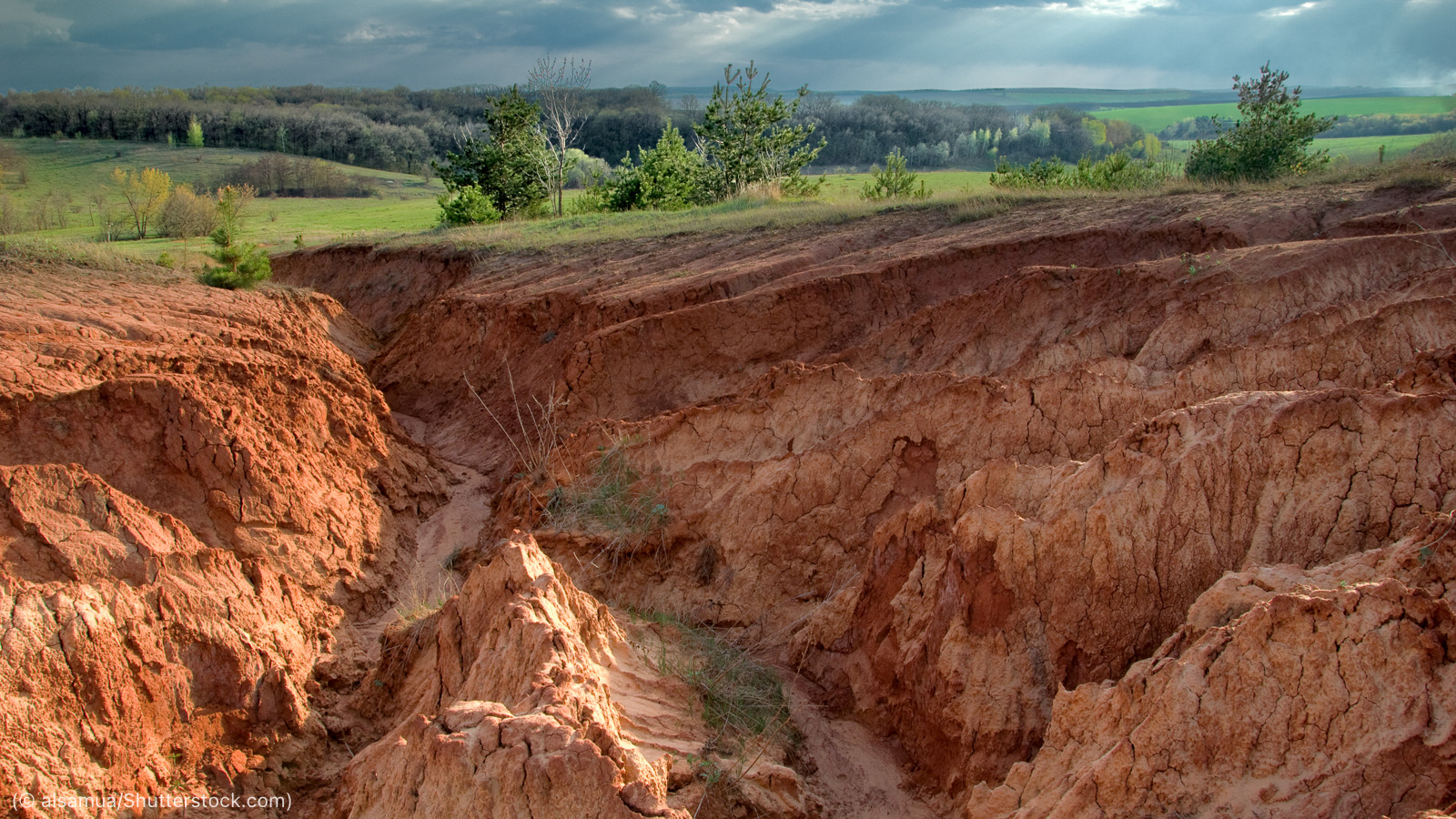ASTANA – Land degradation is among the biggest threats to Central Asia, making the region susceptible to drought, sand and dust storms, and overall economic decline, which demands a unified approach across the region, said the lead scientist at the United Nations Convention to Combat Desertification (UNCCD) Barron Joseph Orr in an interview with The Astana Times.

Erosion of the land in the steppe zone. Photo credit: Shutterstock.com
Land degradation in Central Asia
In a report prepared by the UNCCD science team Olga Andreeva, Xiaoxia Jia and Orr, land degradation in Central Asia is described as secondary salinization in the irrigated lands, soil erosion in the rainfed and mountainous areas, loss of vegetation and detrimental change in the vegetation composition in the rangelands.

Barron Joseph Orr. Photo credit: unccd.int
“Landscapes in Central Asia are among the most rapidly degrading and climate-vulnerable areas worldwide. According to data reported by governments to the UNCCD, over 20% of the total land area in Central Asia is degraded, equivalent to roughly 80 million hectares, an area almost four times the size of Kyrgyzstan. This affects an estimated 30% of the region’s combined population,” said Orr.
The causes of land degradation are varied but are widely attributed to unsustainable agricultural practices, the expansion of crop production to fragile and marginal areas, inadequate maintenance of irrigation and drainage networks and overgrazing near settlements.
“Aridity [high evapotranspiration and less rainfall and surface water] and winder weather are two major natural factors that form vulnerability of the Central Asia region. Vegetation loss and water scarcity are two major stresses caused by unsustainable land use. Central Asia is exposed to extreme weather events and natural disasters caused by climate change and human activities such as intensive agriculture, illegal logging, and unsustainable pasture/livestock management, and unprotected mining,” said Orr.
Kazakhstan’s context
Scientific studies show that 78% of the total land of Kazakhstan is vulnerable to land degradation, ranking first in the Central Asia region, making it a major source area of sand and dust storms.
According to 2019 data from UNCCD, 21.3% of the total land area of Kazakhstan was degraded, making 31.7% of the population exposed to land degradation and more than 58% of the population exposed to drought.
In response, the government of Kazakhstan has committed to restoring over four million hectares of degraded land.
The country has also committed to increasing its productive and sustainably irrigated land area by 40%, ultimately expanding the total irrigated area to two million hectares, while Kyrgyzstan announced to implement, among others, pasture rotation, improved pasture infrastructure in its rangelands. It is expected that through the implementation of sustainable land management practices land degradation will be avoided, reduced, or reversed in over four million hectares of the region.
Under the state afforestation program, Kazakhstan has recently been set to plant two billion trees on an area of 1.5 million hectares, including on the dried-up seabed of the Aral Sea, by 2025.
Combined with the country’s commitment to achieving carbon neutrality by 2060, those measures could reverse some of the effects of land degradation and climate change overall.
Risks associated with land degradation in Central Asia
Land degradation poses a significant socio-economic and public health risk, with its immediate and prolonged consequences already quantifiable.
Research data exposes the intricate connection between land degradation and economic crisis as well as public health issues.
According to the latest research conducted by a group of scientists, including Alisher Mirzabayev, the annual cost of land degradation in the Central Asian region has been estimated to be around $6 billion, including rangeland degradation ($4.6 billion), desertification ($0.8 billion), deforestation ($0.3 billion) and abandonment of croplands ($0.1 billion).
The same research suggests that the costs of action against land degradation are lower than the costs of inaction in Central Asia by five times over a 30-year horizon, meaning that each dollar spent on addressing land degradation is likely to have around five dollars of returns.
“This is a very strong economic justification favoring action versus inaction against land degradation. Specifically, the costs of action were found to equal about $53 billion over a 30-year horizon, whereas if nothing is done, the resulting losses may equal almost $288 billion during the same period,” said Orr, citing the research.
The tangible effects of land degradation include a decrease in land productivity, crop yield and the productivity of livestock farming, loss of ecosystem services and increased dust and sandstorms.
Traditional land management practices that once enhanced productivity and yield are no longer sustainable under the conditions of land degradation, leading to a decline in the income and living standards of the population.
“Such phenomena will ultimately lead to reduced well-being,” said Orr.
With reduced land fertility, it is not just the impact on food production but also the ecological situation that further exacerbates the spread of diseases, increased mortality rates, reduced life expectancy and the prevalence of birth defects.
At the level of communities and ecosystems, land degradation reduces resilience to drought and floods.
“Particularly when coupled with drought or flooding, land degradation can lead to internal and trans-national migration to more favorable areas or where alternative income sources can be found,” said Orr.
Central Asian solutions
The steps taken by Kazakhstan and other Central Asian countries on sustainable land management reflect a growing awareness among regional leaders of the critical role that land depletion may play in water security.
“The issues of healthy land and water security are interlinked, but for Central Asian countries, this is a regional issue. For example, Kazakhstan is dependent on its neighbors for water: 90% of the surface water of Kazakhstan originates from neighboring countries. Kazakhstan also holds the largest areas of agricultural land, much of which relies on irrigation, making intergovernmental cooperation the key to ensuring healthy land, water security and food security through integrated policies and actions,” said Orr.
“As for today, all five Central Asia countries have committed to achieving Land Degradation Neutrality (LND),” said Orr.
UNCCD defines LDN as a “state whereby the amount and quality of land resources necessary to support ecosystem functions and services and enhance food security remain stable or increase within specified temporal and spatial scales and ecosystems.”
“They have also committed to conservation, sustainable land management, and restoration under their Nationally Determined Contributions under the Paris agreement, the Bonn Challenge forest commitments, as well as biodiversity conservation commitments,” added Orr.
Orr also highlighted Kazakhstan’s regional dialogue initiatives working closely with other Central Asian countries, particularly a long-term vision of the Regional Strategy for Sand and Dust Storms Management in Central Asia for 2021–2030, which aims to reduce the vulnerability of Central Asian countries and communities to the effects of sand and dust storms.
“The success stories in Central Asia are being shared within the region and globally. More than 100 sustainable land management technologies and approaches that have been successfully applied in the region have been shared by the government and non-government agencies that introduced them to the global network known as WOCAT (World Overview of Conservation Approaches and Technologies) which hosts an open-access and global database for sustainable land and water management technologies, practices and experiences,” said Orr.
The same regional dialogue approach is implemented on cross boundary river water management.
Addressing land degradation in a coordinated way across all five Central Asian countries is key, according to Orr. The multiple benefits of land must become part of economic development models employed in the region.
“Kazakhstan may wish to accelerate its ongoing efforts to integrate Land Degradation Neutrality targets with its net zero carbon strategy. If the promise of this approach in Kazakhstan is realized, the experience gained could be shared across all five Central Asian countries,” said Or.
“For example, drawing down carbon from the atmosphere through restoration of rangelands and degraded croplands through carbon farming and agroforestry can help create sustainable value chains and the economic vitality of rural areas. Ensuring this investment is coupled with efforts to develop rural-to-urban linkages, thus being a bit less dependent on global markets, will help build resilience. Investing more into such regionally focused carbon smart agriculture and water efficient agriculture approaches are key to a more resilient future, not only in Kazakhstan but across Central Asia,” he added.
Science is essential to identify and monitor drivers of desertification and highlight the most appropriate actions to stop it.
“This great ambition will only be possible with data. It would be advisable to invest more into knowledge generation and monitoring of the existing land and water resources, starting with soils, but also including water, snow and biodiversity resources,” said Orr.


